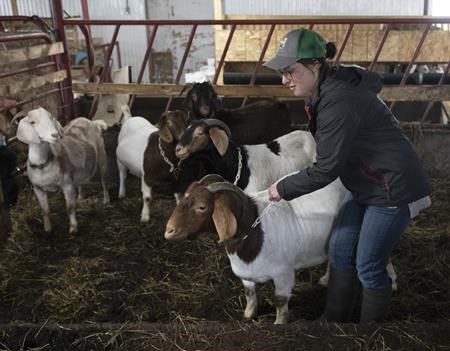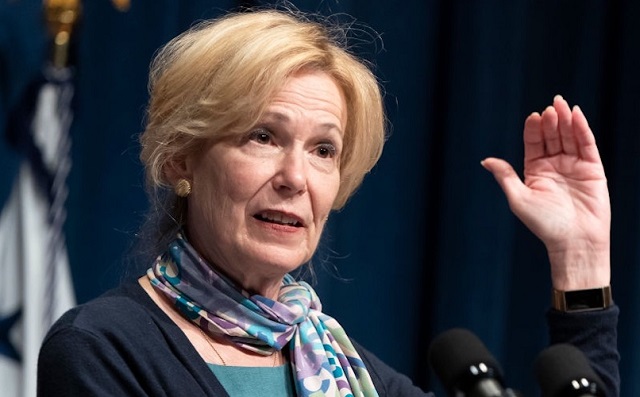Alberta
High costs putting farming out of reach for young people, affecting all Canadians

MONTREAL — When Myriam Landry started raising goats for their meat in 2018, she started small — because she had to.
She opened Chèvrerie aux Volets Verts, in St-Esprit, Que., with two goats; she couldn’t afford a large herd and chose animals small enough that she could handle on her own while pregnant with her third child.
“I should have started bigger … but then I would have needed more money, which I didn’t have,” Landry, 33, said in a recent interview from her farm 50 kilometres north of Montreal.
“It’s really hard for young people to start … I don’t even have land, I don’t have tractors, even my goats (I paid for) on loans.”
The rising cost of land is making it harder than ever for young farmers to enter the business. And those barriers come at a time when a growing number of older farmers are planning to leave the industry. Organizations promoting farm succession worry that if young people are unable to enter the industry, only the largest companies will endure, reducing the diversity of crops and livestock and widening the gap between Canadians and their sources of food.
“The main challenge right now is really the cost of agricultural land,” said Benoît Curé, co-ordinator of ARTERRE, a program that pairs aspiring farmers with landowners and farmers planning to retire.
Curé said multiple factors are contributing to rising prices, including real estate speculation — especially near Montreal suburbs — and strong competition for the best soil in a province where only around two per cent of the land is suitable for farming.
Last year, the price of agricultural land rose by 10 per cent, which isn’t unusual, he said in a recent interview. “Over the last 10 years, we’ve had annual increases of about six to 10 per cent.” The average dairy farm in Quebec is now valued at almost $5 million, he said, almost double what it was in 2011.
With 20 per cent down payments usually expected for farm purchases, “you have to almost be a millionaire before starting your agricultural business,” Curé said. If young people can’t afford to get into farming, then most rural communities risk being left with two or three large farms, he lamented.
Landry, like more than half of the aspiring farmers who have worked with ARTERRE, is renting her space. Her small operation is located on a former dairy farm that’s now used for hay and cereal crops. Her farm has now grown to 40 female goats and a handful of males for breeding. There’s enough space in her barn for 60 females, she said, but she has enough demand to support 100.
And while starting small has allowed her to open a farm, it has also come with its own challenges. Goat meat, she said, is uncommon in Quebec, and financial institutions are hesitant to lend to money for an operation they aren’t familiar with.
Lenders, she said, “don’t want to finance it, because they don’t know it, and that makes it really hard.”
Farming has always been a capital-intensive industry — with high costs for land, equipment and inputs — but prices across Canada have risen above the revenue that can be generated from that land, said Jean-Philippe Gervais, the chief economist of Farm Credit Canada, a Crown corporation that lends to farmers.
“The relationship between the price of the land and the revenue that can be expected from the land — that ratio is the highest we’ve ever seen,” Gervais said in a recent interview. “So we’re really at prices that are the highest we’ve ever seen, not just in absolute value in dollars per hectare, but also relative to what can be generated in income.”
It’s now rare for farmers to turn a profit from land they buy just by farming it, he said, adding that most farmers only make their money back when they sell. Large, established farms can fund the purchase of more land from the revenue generated on land that’s already been paid for, he added.
But even large farms are challenged by high costs. A survey of more than 3,600 farmers released last month by Quebec’s farmers association found that 11 per cent are thinking about closing over the coming year. The Union des producteurs agricoles found that costs on Quebec farms rose by an average of 17.3 per cent in 2022 while revenues rose by an average of 14.7 per cent.
A report released in early April by RBC found that 40 per cent of Canadian farm operators planned to retire over the next decade and that 66 per cent didn’t have a succession plan.
Julie Bissonnette, the president of an organization that represents young Quebec farmers and promotes farm succession, says there are many young people interested in agriculture.
“Sometimes you hear there’s no one to take over, but it’s not true, there are a lot, but we need to make sure they’re able to set up,” Bissonnette, with the Fédération de la relève agricole du Québec, said in a recent interview. “It’s so much money.”
Urban sprawl and the influx of people moving to rural areas to work remotely is putting increased pressure on Quebec’s arable land, Bissonnette said.
Landry, meanwhile, said she’d like to see more small-time farmers because they tend to build close relationships with local residents.
“We need to reconnect the public to what they do three times a day, which is eat,” she said. “Know where your food is coming from. If you can’t grow it yourself, find someone who does it the way you would do it.”
This report by The Canadian Press was first published May 7, 2023.
Jacob Serebrin, The Canadian Press
Alberta
Pharmacist-led clinics improve access to health care: Lessons from Alberta

News release from the Montreal Economic Institute
In Canada, 35 per cent of avoidable emergency room visits could be handled by pharmacists.
Emulating Alberta’s pharmacist-led clinic model could enhance access to primary care and help avoid unnecessary emergency room visits, according to a new study from the Montreal Economic Institute.
“Pharmacists know medication better than anyone else in our health systems,” explains Krystle Wittevrongel, senior public policy analyst and Alberta project lead at the MEI. “By unlocking their full potential in prescribing and substituting medications, Alberta’s pharmacist-led clinics have helped avoid tens of thousands of unnecessary emergency room visits.”
Pharmacists in Alberta have the largest prescribing authority in the country, including the ability to prescribe schedule one drugs with special training.
Unlike in Ontario and Manitoba, Alberta pharmacists are authorized to substitute prescribed medications, which can help address issues such as adverse reactions caused by interaction with other treatments.
The study explains that this can help reduce pressure on hospitals, as prescription-related issues account for more than 10 per cent of emergency room visits.
Alberta’s first pharmacist-led clinic, in Lethbridge, sees between 14,600 and 21,900 patients per year since opening in 2022.
It is expected that there will be 103 such clinics active in the province by the end of 2024.
The researcher also links the success of the pharmacist-led clinic model in Alberta to pharmacists’ expanded scope of practice in the province.
Among other things, Alberta pharmacists are able to order and interpret lab tests, unlike their counterparts in British Columbia, Ontario, and Newfoundland and Labrador.
A 2019 peer-reviewed study found that pharmacists could handle 35 per cent of avoidable emergency room visits in Canada.
“By enabling pharmacists to play a larger role in its health system, Alberta is redirecting minor cases from emergency rooms to more appropriate facilities,” said Wittevrongel. “Just imagine how much faster things could be if pharmacists could take care of 35 per cent of the unnecessary load placed on Canada’s emergency rooms.”
The MEI study is available here.
* * *
The MEI is an independent public policy think tank with offices in Montreal and Calgary. Through its publications, media appearances, and advisory services to policy-makers, the MEI stimulates public policy debate and reforms based on sound economics and entrepreneurship.
Alberta
Province announces next step to revamped health care system

Setting the foundation for a refocused health system
Proposed legislation would support the refocusing of Alberta’s health care system to ensure Albertans get the care they need when and where they need it.
On Nov. 8, 2023, Alberta’s government announced plans for a refocused health care system to ensure patients are receiving the care they need, when and where they need it. To achieve this, Alberta’s government will be creating four new organizations, one for each priority health services sector: acute care, primary care, continuing care and mental health and addiction.
If passed, the Health Statutes Amendment Act would enable the government to take the necessary next steps to refocus the province’s health care system. The legislation would ensure Albertans have a system that works for them by prioritizing their need to find a primary care provider, receive urgent care without long waits, have access to the best continuing care options and obtain excellent mental health and addiction treatment.
“We are taking another step toward improving health care by updating legislation and enabling the governance and oversight required to refocus the health system. The critical improvements to transparency and accountability will help support the successful refocusing of the health care system to one that is responsive, effective and reflects the needs and priorities of Albertans today and for future generations.”
The Health Statutes Amendment Act will enable the transition from one regional health authority, Alberta Health Services, to an integrated system of four sector-based provincial health agencies including primary care, acute care, continuing care and mental health and addiction. The agencies will be responsible for delivering integrated health services, ensuring Albertans receive timely access to care, regardless of where they live.
The Health Statutes Amendment Act establishes roles for an oversight minister and sector minister. The Minister of Health will take on the role of oversight minister, responsible for setting the strategic direction of the overall health system. A sector minister will be responsible for a specific health services sector. For example, the sector minister for Recovery Alberta is the Minister of Mental Health and Addiction. On the recommendation of the oversight minister, additional health service sectors may be established and designate a minister responsible for that newly created sector.
Enhanced government oversight will help Alberta’s government to better direct resources to the front lines where they are needed the most, improve patient care overall and support health care professionals.
“Mental health and addiction have been growing issues within our society and need to be prioritized within our health care system. Amid an addiction crisis, a refocused health system will allow for mental health and addiction services to get the attention, oversight and focus they need. Recovery Alberta would allow for improved mental health and addiction care across the province as an important part of an integrated health system.”
“Refocusing Alberta’s healthcare system is a crucial step towards ensuring that we can deliver a framework that prioritizes accessibility, accountability, and patient-centered care. By streamlining operations, improving oversight and fostering collaboration, we are setting a strong foundation for a healthcare system that is better equipped to address the diverse needs of each of our communities.”
The legislation will enable the minister of health to transfer employees or classes of employees from AHS to the new sector-based organizations, once established. During the transition period, AHS will be enabled to continue operating as a regional health authority. Employee transfers will be seamless, maintaining existing bargaining relationships and collective agreements. This will ensure stability for the workforce, unions and government as the health system refocus is implemented. There will be no job losses for staff who transition into the new organizations.
Amendments to be made to existing legislation
The Health Statutes Amendment Act includes amendments to the Regional Health Authorities Act and the Health Information Act, which have not been updated since the 1990s.
As part of these amendments, the name of the Regional Health Authorities Act will change to the Provincial Health Agencies Act. The amended Provincial Health Agencies Act will remove outdated references to allow the transition from a single regional health authority to a unified, sector-specific provincial health system. This will clarify the scope and accountabilities of provincial health agencies and health service providers going forward.
The amendments will also place responsibility on the provincial health agencies for operational planning and oversight of clinical service delivery across the province. This will enable provincial health agencies to set priorities in the provision of health service delivery. The agencies will also be tasked with sharing information and collaborating closely to support seamless patient care as the transition to the refocused health care system takes place.
Alberta’s government is committed to ensuring that patient information continues to remain safe and secure through this transition. Amendments to the Health Information Act will be introduced to support the new health system refocus and to support the establishment of the Canadian Centre of Recovery Excellence. These amendments will allow the Ministry of Health, the Ministry of Mental Health and Addiction, the four new provincial health agencies, the Health Quality Council of Alberta and Canadian Centre of Recovery Excellence to have the authority to use health information for health system purposes.
If passed, the Health Statutes Amendment Act will enable Recovery Alberta, the mental health and addiction provincial health agency, to begin operating in the summer of 2024. The primary care, acute care and continuing care provincial health agencies are expected to be established in the fall.
Quick facts
- Consequential amendments are changes made to existing legislation due to new legislation being passed. These amendments are necessary to ensure legislative alignment with the proposed amendments to the Regional Health Authorities Act.
- To support the Regional Health Authorities Act amendments and ensure alignment, 43 other acts are being consequentially amended – for example, to replace references to “regional health authority” with “provincial health agency” where necessary.
- AHS will remain a key provider of health services, and in fall 2024 will transition to focusing on the provision of acute care services.
- Alberta’s government introduced the Canadian Centre of Recovery Excellence Act which, if passed, will establish the Canadian Centre of Recovery Excellence (CoRE) as a public agency that would support the Government of Alberta, including Mental Health and Addiction, and Recovery Alberta in advancing the Alberta Recovery Model.
Related information
- Establishing the future of Alberta health care
- Refocusing health care in Alberta
- Recovery Alberta
- Canadian Centre of Recovery Excellence
- Bill 22: Health Statutes Amendment Act, 2024
Related news
- Refocusing on patient-centred care (Nov. 8, 2023)
-

 COVID-192 days ago
COVID-192 days agoFormer COVID coordinator Deborah Birx now admits jabs could have injured ‘thousands’
-

 Opinion2 days ago
Opinion2 days agoCanada’s fertility, marriage rates plummet to record lows: report
-

 Health1 day ago
Health1 day agoPrivate Footage Reveals Leading Medical Org’s Efforts To ‘Normalize’ Gender Ideology
-

 Alberta1 day ago
Alberta1 day agoRed Deer Hospital Lottery – Second Chance Early Bird Prize!!!
-

 armed forces24 hours ago
armed forces24 hours agoTrudeau government has spent $10 million promoting DEI in the military as recruitment flounders
-

 illegal immigration2 days ago
illegal immigration2 days agoPanama’s Incoming President Wants To Shut Down His Country’s Most Treacherous Route For Migrants — But Will It Work?
-

 COVID-1923 hours ago
COVID-1923 hours agoMore victories for freedom as ArriveCAN charges dropped and fines reduced
-

 City of Red Deer2 days ago
City of Red Deer2 days agoCity Council paving the way for more house suites, backyard suites, tiny homes, and duplexes








